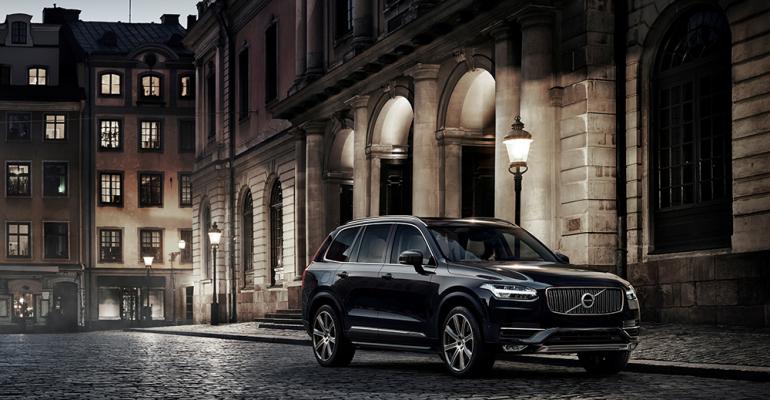STOCKHOLM, Sweden – Volvo is entering a busy period as it completes the launch of the all-new ’16 XC90 fullsize CUV and sets out to design and develop eight new models scheduled to debut by 2019.
All of the planned new models will be based on two new Volvo-developed platforms: the Scalable Product Architecture and Compact Modular Architecture, the latter jointly created with Chinese parent Zhejiang Geely.
CMA is expected to underpin new versions or replacements of the C30 and V40, among other models, while SPA will be used for larger vehicles, such as a new S80 flagship sedan, expected to be named the S90.
Lex Kerssemakers, Volvo vice president-product planning, doesn’t disclose the launch cadence for the new vehicles, but says the decision to rollout the XC90 CUV first makes sense, even though it is the most expensive vehicle in the Volvo lineup.
“The XC90 is 13 years old and it is such an icon for Volvo. The only reason we didn’t do it before is because there was no platform from (former parent) Ford,” he tells journalists at the XC90’s unveiling here. “It’s always dangerous from an economic perspective to start with the most expensive car for development, but we managed.”
Kerssemakers says Volvo expects the XC90 to sell about 80,000 units annually in its first full year. The new CUV will go on sale in the U.S. in April. The automaker offered an initial run of 1,927 special-edition XC90s online, selling out in 47 hours. The number of units was chosen to commemorate the year the Swedish automaker was founded.
Some of the smaller vehicles based on the CMA currently are in the works and will be ready before 2019. Geely also will derive vehicles from CMA, Kerssemakers says.
“They want to do certain things and we need to do certain things, and it’s good for the volumes,” he says. “Volvo has never made a C-car on its own. We used to do it with Mitsubishi and then with Ford.”
Kerssemakers says Volvo was unable to update its C-segment products because of an agreement with Ford about use of its platforms.
The Ford-derived C-car architecture is “a good platform, but part of the deal when Ford sold us was that the V40 would be the last car we were going to use the platform, which is OK,” he says.
No China-Built Cars in U.S. for Now
Initial plans call for all Volvo C-cars for the U.S. and European markets to be built in Sweden, while Volvo models destined for China will be built domestically. It’s possible China-made Volvo cars will make their way to U.S. and Europe in the future, Kerssemakers says, dismissing the notion that Western customers may shy away from a China-built car.
“We investigated it, but at the moment China production goes to China and European (output) goes to the U.S.,” he says. “I don’t think it would be a big issue (with U.S. consumers), if you look at the (success of the China-made) iPhone.”
Kerssemakers says the S60L currently being made in China has quality equal of cars produced in Sweden, noting Swedish managers are on site at the plant and Chinese workers are eager to be the best.
Volvo also is investigating offering an entry-level luxury car in the U.S. The entry-level C30 was pullued from the U.S. market following the ’13 model year. Kerssemakers says while there are no concrete plans to do so, the idea is intriguing.
“It’s an interesting segment development, that’s for sure,” he says of the recent debuts of entry-level luxury cars such as the Mercedes CLA. (The segment) is catching on in Asia and the U.S., but not so much in Europe, at least not yet.”
The automaker hopes the addition of new models over the next five years will help it meet its ultimate goals of selling 800,000 vehicles globally by 2020. Last year, Volvo’s worldwide sales hit 420,000 units. The automaker’s peak was in 2007 with 458,000 deliveries.
Kerssemakers says of the 800,000 projected sales by 2020, about 200,000 will be in China, with 130,000 in the U.S. The rest will go to other global markets, he says.
All the new models will be powered by 4-cyl. engines, including supercharged and turbocharged versions, as well as a Volvo-developed plug-in hybrid.
The XC90, for example, will be offered with powertrain options including the top-of-the-range plug-in hybrid ‘Twin Engine’ PHEV, which combines a 2.0L supercharged and turbocharged gasoline engine powering the front wheels and a 60-kW (80-hp) electric motor driving the rear wheels.
The powertrain will enable the XC90 to operate on electric power for about 25 miles (40 km) and then switch to combined gasoline and electric power. Projected output is about 400 hp and 472 lb.-ft. (639 Nm) of torque.
A luxury automaker only offering 4-cyl. engines is a “new way of thinking,” Kerssemakers admits, adding it’s the right thing to do to reduce emissions and is in line with Volvo’s heritage.
“There will always be customers that want to continue with 8-cyl. engines, but those weren’t necessarily Volvo customers anyhow,” he says. “We know our customers and we did a lot of research before we did this. We’re going in very confident.”





